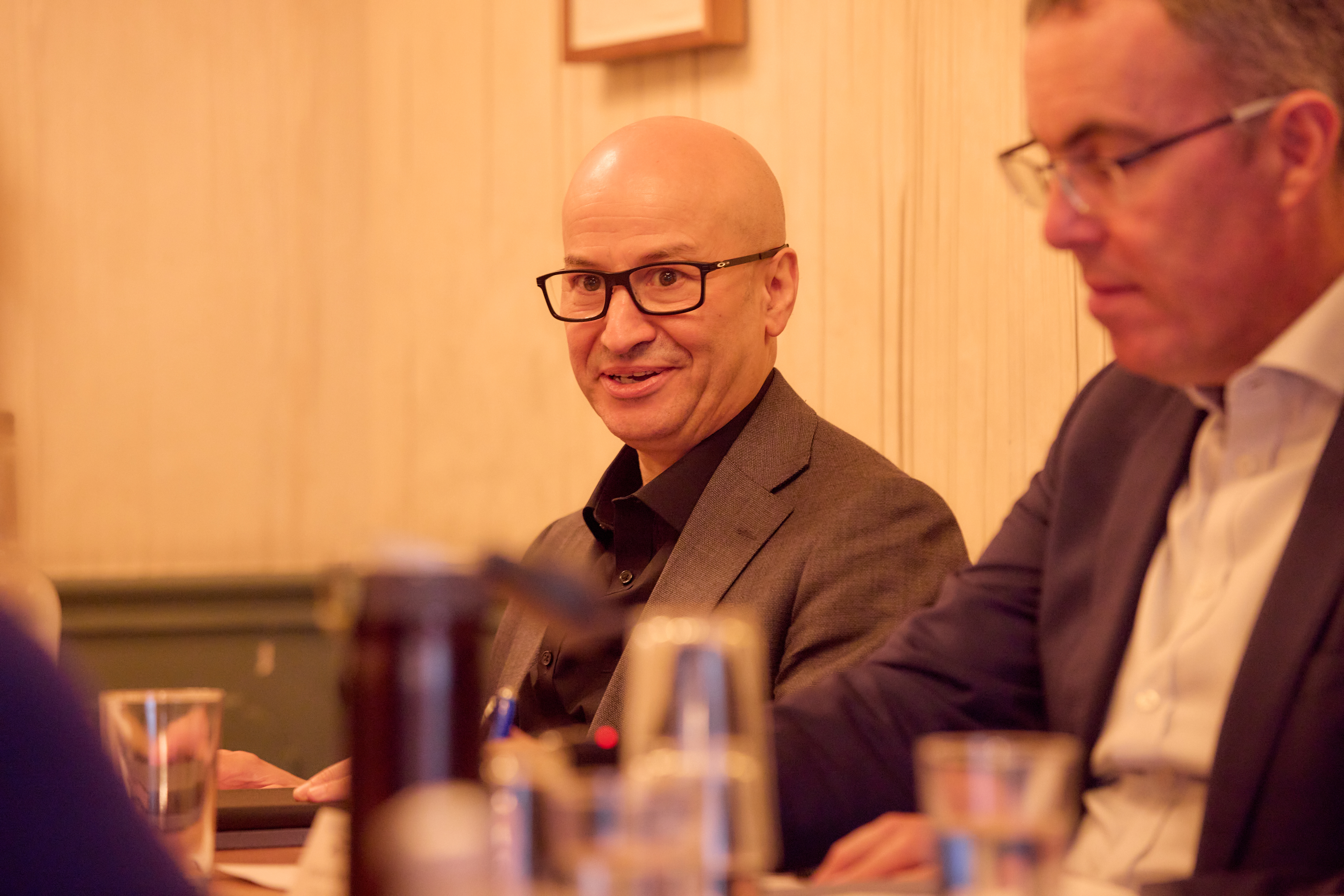On 11 September, Professional Pensions assembled a panel of experts to discuss government moves on easing restrictions on how scheme surpluses are used.
The conversation – chaired by PP editor Jonathan Stapleton and held in association with Russell Investments – focused on whether measures introduced in the Pension Schemes Bill could allow even more schemes to run-on and invest their assets for longer rather than immediately move to insurance-based options such as buy-in or buyout.
The panel discussed the extent to which the views of trustees, sponsors. members and other key stakeholders have changed and the implications of a potential move to run-on.
Key findings included:
- Buyout remains the preferred endgame for many schemes: There has been a limited take-up of run-on so far, with smaller schemes deterred by cost and uncertainty, and larger ones waiting for clearer surplus rules.
- Strong governance needed: Successful run-on depends on robust risk management, liquidity, and stress testing to manage market and longevity risks.
- Better alignment required: Trustees, sponsors, and members need clearer communication and shared understanding of risks, rewards, and surplus use.
What are your views on the new surplus flexibilities and have they changed views in respect to run-on?
Judith Fish (Dalriada Trustees): I'm not seeing as many changes as I expected. A lot of employers are saying ‘enough is enough'. There has been too much regulatory change in the past, including the threat of the Virgin Media case, and it has been one thing after the other for employers. Most of my schemes are still targeting buyout, even some of the larger ones. A couple of the larger schemes I'm working on will run-on for a bit but run-on isn't really an option for the smaller ones – they are too small, and ongoing costs will swamp out any benefit they could get.
Aqib Merchant (Russell Investments): Run-on is talked about a lot but not many schemes are actually taking the leap. Those that are looking at it tend to be larger. Ultimately, I think we are finding that people are still digesting this - they want to see exactly what the regulations will be and how easy it will be for them to implement. At the same time, how do you balance what you have been doing for so long against changing direction? Going through that discussion with sponsors and trustee boards and factoring members' views is going to take time.
Judith Fish: The other issue is that there seems to be a huge emphasis on trustees. How easy will it be for trustees to share surplus when they can't be certain of the future? Historically, how many cases have we seen of schemes that were well funded suddenly finding themselves with either a weak or non-existent employer?
Mohsin Harhara (Skanska UK): I agree. It only takes a major unexpected market crisis to potentially turn things around. For that reason, if you are going towards run‑on, you really need to think carefully about the investment strategy and how it can mitigate those risks. The legislation also needs to impose robust safeguards and controls on, for example, the use of surplus for share buybacks to enhance share prices or to fund dividend payments.
Arlene Mitcham (AMNT): That is the issue. As you said, I think most pension funds are too small to be able to deal with run-on. I think unless the legislation changes to try and help trustees and company sponsors manage, or at least mitigate, some of the risks, you are not going to take that step forward. I think there is still more discussion that needs to occur with regard to the direction of travel that the government is proposing. Clearly, what the government wants is for pension funds to bite and to be part of that discussion and opportunity, but there is little to temp a trustee or sponsoring company to actually want to do that.
Judith Fish: A lot of pension schemes have de‑risked their investments quite materially, and their biggest risk is now actually longevity. There is not a market for medium‑sized schemes of around half a billion to easily get any longevity insurance to mitigate that risk.

Simon, are you sensing any change in opinion among trustees, sponsors and other key stakeholders?
Simon Partridge (Russell Investments): I do not think there has been a significant movement. There has been a lot of talk about this in the industry, and all of our clients have been discussing the potential benefits and risks of run‑on. Is the incentive there from all parties? Trustees have to look after the members' benefits and keep that in mind.
Ultimately, it is always that balance of who is going to benefit from running-on, surplus extraction, or discretionary increases. Does the corporate really benefit from that net of tax? Will the tax regime change? I think there is so much uncertainty. Often the status quo is seen as the boring option, but actually, surprisingly, I think the status quo is still the sensible one for many of these schemes. Buyout is still the preferred option for many.
Judith Fish: I think buyout is probably the eventual option. Even with run-on, that will only last until a scheme's size is no longer worth it running on. I know schemes with run-on targets that have an agreed process for surplus extraction in terms of how much goes to the members, to the employer, and what gets retained within the scheme to provide that extra buffer. Those conversations are happening. There will be schemes or employers that benefit from this, and they are able to get some of their surplus back without having to wait for buyouts, but, as with everything the government does, it always feels a bit too little, too late.
Aqib Merchant: A lot of those schemes will need that certainty now on what it looks like. I was doing some modelling on what a £500m pension scheme could do. It was almost reversing what we have always been doing. We have had deficit recovery plans, but when it comes to run-on surplus recovery plans may be needed – setting out a schedule into the future where whatever surplus is generated every year is shared between the sponsor and members. The challenge is getting everyone on board to understand and implement that without clear certainty on what the regulations will look like or where they'll ultimately land.
Mohsin Harhara: These models need stringent stress tests for adverse market conditions. I can certainly see the appeal of a run-on recovery plan model to gradually release surplus in a prudent way which would mitigate any regret risk.
Arlene Mitcham: It is good that you are modelling it though, because I think that is really where the market needs to be – it is these sort of models that give the market some confidence to actually have that discussion.

Are these models predicated on a credit-heavy or cashflow-driven investment strategy?
Aqib Merchant: Cash flow investing is crucial. Schemes need to pay benefits with no contributions coming in, cover ongoing expenses and still have the flexibility to distribute surplus to the sponsor or enhance member benefits. Cash flow investing is important, but credit spreads are so tight that you cannot really generate any premium just by going into investment‑grade credit. Investment‑grade credit spreads are 70 basis points over gilts, so you are not achieving the kind of modelling people were doing a couple of years ago. You still need to have some liquid assets like equities in there because they have been really strong performers in diverse portfolios. Also, we always talk to our clients about semi‑liquids, where you have quarterly liquidity and use that premium to generate the additional return because investment‑grade credit will not.
Simon Partridge: I think that even within that investment‑grade credit, the tradition for UK schemes has been to invest in sterling bonds to match cashflows and currency – but that is such a small universe and it is also completely dominated by UK pension fund investors. We need to think about more diversified portfolios and investing overseas – the US and European markets for instance – continuing to retain security and high credit worthiness. We should consider more alternative arrangements and moving to a much broader universe to diversify risk.
Judith Fish: Trustees and employers need to have more conversations about where their schemes are going because it is fundamental to how you invest and fund the scheme. I think that those conversations are happening but also think they probably need to happen more frequently. When you make a decision, it is not a decision once and for all – you need to think about whether anything has changed in the world and whether you still have the right strategy.
You need to make sure everyone around the table has the same level of education so there is full understanding of the pitfalls and the risks.
I suspect that the surplus discussions and how any surplus is split is probably led by the employer but it will depend on the balance of powers and the scheme rules as well - I think that will be quite key.

To what extent are finance directors aware of run-on?
Mohsin Harhara: I can certainly say that our finance director is aware of and understands the options available. The issue is that quite a number of schemes may now be very close to buy-in and past the point of no return, which is why you have probably not seen a seismic shift towards run-on yet. I also think a good proportion of the schemes that are not quite there yet will continue to transact a bulk annuity as soon as they have the opportunity, as many finance directors will be keen to remove pension liabilities from their balance sheets.
Simon Partridge: There are other instances where finance directors may be more motivated to run their scheme on. For instance, if there is a US sponsor involved, US GAAP accounting rules, among other things, may make it beneficial to keep the scheme running. If they send it to a buyout, this could have a substantial impact on the balance sheet.
More broadly, however, finance directors and sponsors have had to finance and support their pension schemes for so long, is surplus extraction now actually going to make sense, or does that leave the finance director with more of a problem of balancing other things? I don't think it is as simple as just extracting some surplus, it is about much broader accounting conversations as well.
Judith Fish: The UK is bringing in new surplus rules, but they are not there yet. If a company currently has a scheme with a buy‑in surplus that it thinks it can crystallise and book, for instance, in 2028, does it really want to risk this certainty of getting tens of millions back in 2028 versus the possibility of something dribbling back over time on rules that still have not been finalised?
The regulator has been incredibly busy doing so many things and look how long it took for the funding code to come in. If that were to repeat, employers are going to say, ‘Well actually, I can buy‑in and get my surplus in 2028, or I can wait for the regulations to come out and I might be getting a tenth of that back in 2031. I think that might put some finance directors off.
How does the DB funding code fit in when it comes to run-on?
Simon Partridge: It is a relief that it has finally been published. As Judith said, it took a long time to come out but it gives us more certainty as well as some flexibility. Schemes we're working with now have specific timeframes written down but, now that the definition of significant maturity has been clearly written down, we can work within those bounds and start to think about some more flexible ways of running a scheme, whether that is for surplus generation or a buyout. I think all these discussions, pieces of legislation, or indeed codes, are working together. It is just important that there is that broad dialogue around the table with trustees and sponsors so that everyone's interests are as aligned as they can be.
How do we ensure member voices are heard?
Aqib Merchant: For many years members feared underfunded schemes and hoped for stronger funding position. Now that they are fully funded, they do not want the sponsor to start taking the money out of the scheme but to secure members' benefits instead. Not every member really understands the nuances. I think there is an information barrier for them to really understand what a surplus extraction might mean for their scheme.
Arlene Mitcham: I think members may not understand, but that is because we have not taken the time to communicate to them. It is not the member's fault. It is how we communicate the information, and, often, I do not think we present the information in a manner that is of interest to members. We tend to do it in a manner that is of interest to either the company, the providers, the insurers or the consultants, but the member has to go through hoops to work out what that means to them. At the end of the day, I just don't think we communicate to members in a manner that makes it easy for them to follow the conversation.
Mohsin Harhara: I think it's crucial that members are kept informed well in advance of any endgame strategy being implemented. Communications need to assure them that their pensions are secure regardless of whether the route being taken is towards run-on or buyout Any lack of communication can create cynicism in members. For example, if schemes are going to buy‑in or buyout for the right reasons, some members might construe that as being because the company wants to wash their hands of it – perhaps they would rather have the safety of the company that they have worked for over so many years.
Arlene Mitcham: Also, as a member, you are not aware of all the constraints that trustee boards have to operate under. From that point of view, you don't necessarily have the understanding as to why it is better for all those parties involved to go to buy‑in rather than running-on and continuing to carry on with things the way they are.

Aqib, if sponsors, trustees and boards are thinking of running-on but want to wait to see what the final regulations look like, what should they do now in terms of investment strategy?
Aqib Merchant: Every scheme first needs to focus on securing its low dependency position. It is that journey first – that is the first milestone you need to get to, and that also aligns with the DB funding code, which focuses a lot on achieving that low dependency position.
When thinking about a run-on solution, it's about gradually ratcheting up risk while building a buffer – something that ties in really well with the DB funding code's maximum resilience tests on the maximum contribution that the sponsor can put in. I am getting a little technical here, but you start building that buffer so that your value at risk is over and above the buffer that you are building up. You gradually increase the risk along the way, and you could get the scheme on that journey in the lead‑up to any regulations if you are thinking about run‑on.
This is a very complex area. Simon, how can fiduciary management or OCIO help?
Simon Partridge: We have seen continued interest in an outsourced approach to managing scheme assets. There are a number of benefits from that, not just how the assets are going to be managed on an ongoing basis. All those discussions, analysis, modelling, risk scenarios and stress testing is something that we do day in, day out and communicating to trustee boards, sponsors, members and whoever needs to see that information is all within that fee, it is not an additional cost.
Coming back to governance, it is then an ongoing consideration of how assets are going to be managed. If circumstances change and there is suddenly a change of trustee board, financial director or a scenario within the scheme or corporate, how are you going to be flexible enough to pivot those assets? How can you change the course? That can all be managed by that fiduciary manager. The key is knowing who is responsible for each piece of activity and who has the accountability for each aspect, as well as the ability to make those changes nimbly, efficiently and in the interest of the whole pension scheme.
What happens when there's a change? How easy is it to unwind and pivot to something else?
Aqib Merchant: I think that is where we always say run‑on and a buyout are not mutually exclusive. You could be running on for a few years and then decide to go to buyout because, at that point, the pricing is really attractive for your scheme. Again, it goes back to whether your investment strategy is locking you up for a long period of time. That is what you ultimately want to avoid. It is the liquidity which becomes the biggest challenge. Liquidity can be managed by moving into semi‑liquids. That gives you that quarterly liquidity, which means that in a couple of quarters you can very quickly be ready to move to a different position or change direction if that is what is needed.
Is there currently sufficient clarity on how surplus can be taken out?
Simon Partridge: It will often be more challenging for the first schemes and corporates going through that process but once it gathers more steam, you will get more innovation. Saying that, it still remains to be seen how many schemes will progress to the point of surplus extraction, but the more options available and the more communication out there about the approach, the better. As Aqib suggested, things like staged surplus release are possible options and I think there will be more innovation when it comes to different approaches to surplus extraction in the future. The pensions industry is good at innovating and coming up with ideas, but it often takes a number of years for those ideas to actually come to fruition.
Judith Fish: There needs to be innovation around how you share surplus with members, which currently isn't flexible enough.

What are your key takeaways or final thoughts following this discussion?
Mohsin Harhara: One of the key things for me in terms of run-on is about the risk of adverse market traumas in the future. I think setting the buffer and investment strategy, and really stress testing it, is going to be incredibly important, because we do not want to be in the position that we were in ten years ago with most of the schemes in the UK in deficit. The shift to run-on will be gradual but will likely gain traction as there will invariably be schemes that are keeping their options open until there is more regulatory certainty.
Arlene Mitcham: I suppose I would like to build on the points made earlier about timing. I think, for some schemes, the conversation around running-on and surplus extraction is possibly a bit too late because they are already in the mindset of buyout. Given time, however, for those people who can wait while the government is working through the regulatory environment, there will be more of an opportunity going forward. I do think the pension products will change for the better, but it is just going to take more time
Aqib Merchant: Strong risk management is essential for every pension scheme – no matter which objective you end up selecting, whether it is run-on or buy-in. Enhancing governance and investment risk frameworks, both points which we have talked about, remain critical irrespective of the end game choice which schemes make.
Judith Fish: I think run-on will be right for some schemes. Saying that, while schemes can manage their investment risk, they will still need to manage their longevity risk – the latest longevity tables show a jump in longevity and schemes with valuations coming up may well see a fall in their funding levels because of that. Could we then see insurers concentrating on longevity products to help schemes run-on and then potentially help them again with a buy-in when they diminish in size?
Also, when you are talking about schemes for whom it makes sense to run-on, the value of assets does need to be large enough to generate enough return to pay for your ongoing costs. And, even as larger schemes mature, their asset size is going to diminish – a billion pound scheme could have shrunk quite significantly in ten years' time and may well start thinking about the point at which it goes to buyout.
I think it will be interesting to see what happens. I do think some schemes will go for run-on, but I think they should consider the longevity risk when doing so.
Simon Partridge: While there is more regulatory clarity now, there are more questions as well, as we have discussed today. Even if you have been able to extract some surplus, what do you do with it? How do you share it and who does it go to?
Ultimately, I think it comes back to everyone keeping an open mind, discussing things and making sure there is open discussion between trustees, the sponsor and all the key stakeholders. As Aqib just mentioned, you need to make sure you have got the governance in the right place – knowing who is doing what, when and how. You also need to know what you own on the investment side of things so that, if circumstances change, or you need to make a quick movement one way or the other, you can do that.
This roundtable was held on 11 September 2025 in association with Russell Investments





